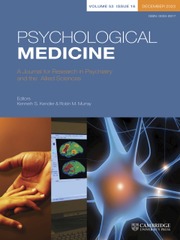Crossref Citations
This article has been cited by the following publications. This list is generated based on data provided by
Crossref.
Shushakova, A.
Wiesner, C.D.
Ohrmann, P.
and
Pedersen, A.
2018.
Electrophysiological evidence of an attentional bias towards appetitive and aversive words in adults with attention-deficit/hyperactivity disorder.
Clinical Neurophysiology,
Vol. 129,
Issue. 9,
p.
1937.
Michalek, Anne M. P.
Jayawardena, Gavindya
and
Jayarathna, Sampath
2019.
Computational Models for Biomedical Reasoning and Problem Solving.
p.
66.
Pulini, Alfredo A.
Kerr, Wesley T.
Loo, Sandra K.
and
Lenartowicz, Agatha
2019.
Classification Accuracy of Neuroimaging Biomarkers in Attention-Deficit/Hyperactivity Disorder: Effects of Sample Size and Circular Analysis.
Biological Psychiatry: Cognitive Neuroscience and Neuroimaging,
Vol. 4,
Issue. 2,
p.
108.
Adamou, Marios
Fullen, Tim
and
Jones, Sarah L.
2020.
EEG for Diagnosis of Adult ADHD: A Systematic Review With Narrative Analysis.
Frontiers in Psychiatry,
Vol. 11,
Issue. ,
Song, Shanghu
Qiu, Jianfeng
and
Lu, Weizhao
2021.
Predicting disease severity in children with combined attention deficit hyperactivity disorder using quantitative features from structural MRI of amygdaloid and hippocampal subfields.
Journal of Neural Engineering,
Vol. 18,
Issue. 4,
p.
046013.
Hassin-Baer, Sharon
Cohen, Oren S.
Israeli-Korn, Simon
Yahalom, Gilad
Benizri, Sandra
Sand, Daniel
Issachar, Gil
Geva, Amir B.
Shani-Hershkovich, Revital
Peremen, Ziv
and
Mumtaz, Wajid
2022.
Identification of an early-stage Parkinson’s disease neuromarker using event-related potentials, brain network analytics and machine-learning.
PLOS ONE,
Vol. 17,
Issue. 1,
p.
e0261947.
Liang, Zhenhu
Wang, Xinrui
Zhao, Jing
and
Li, Xiaoli
2022.
Comparative study of attention-related features on attention monitoring systems with a single EEG channel.
Journal of Neuroscience Methods,
Vol. 382,
Issue. ,
p.
109711.
Koh, Joel.E.W.
Ooi, Chui Ping
Lim-Ashworth, Nikki SJ.
Vicnesh, Jahmunah
Tor, Hui Tian
Lih, Oh Shu
Tan, Ru-San
Acharya, U.Rajendra
and
Fung, Daniel Shuen Sheng
2022.
Automated classification of attention deficit hyperactivity disorder and conduct disorder using entropy features with ECG signals.
Computers in Biology and Medicine,
Vol. 140,
Issue. ,
p.
105120.
Chen, Zhiyi
Hu, Bowen
Liu, Xuerong
Becker, Benjamin
Eickhoff, Simon B.
Miao, Kuan
Gu, Xingmei
Tang, Yancheng
Dai, Xin
Li, Chao
Leonov, Artemiy
Xiao, Zhibing
Feng, Zhengzhi
Chen, Ji
and
Chuan-Peng, Hu
2023.
Sampling inequalities affect generalization of neuroimaging-based diagnostic classifiers in psychiatry.
BMC Medicine,
Vol. 21,
Issue. 1,
Cao, Meng
Martin, Elizabeth
and
Li, Xiaobo
2023.
Machine learning in attention-deficit/hyperactivity disorder: new approaches toward understanding the neural mechanisms.
Translational Psychiatry,
Vol. 13,
Issue. 1,
Chen, Zhiyi
Liu, Xuerong
Yang, Qingwu
Wang, Yan-Jiang
Miao, Kuan
Gong, Zheng
Yu, Yang
Leonov, Artemiy
Liu, Chunlei
Feng, Zhengzhi
and
Chuan-Peng, Hu
2023.
Evaluation of Risk of Bias in Neuroimaging-Based Artificial Intelligence Models for Psychiatric Diagnosis.
JAMA Network Open,
Vol. 6,
Issue. 3,
p.
e231671.
Zajecka, John
Laufer, Offir
Peremen, Ziv
Sholtes, David
Mackey, Ian
Baumeister, Charlotte
White, Amanda
Geva, Amir B.
and
Issachar, Gil
2024.
Evaluating an EEG-based tool for assessing acute clinical and cognitive changes in adult outpatients with MDD treated with open-label, flexible-dose vortioxetine: A pilot study.
Journal of Affective Disorders Reports,
Vol. 16,
Issue. ,
p.
100732.
Salazar de Pablo, Gonzalo
Iniesta, Raquel
Bellato, Alessio
Caye, Arthur
Dobrosavljevic, Maja
Parlatini, Valeria
Garcia-Argibay, Miguel
Li, Lin
Cabras, Anna
Haider Ali, Mian
Archer, Lucinda
Meehan, Alan J.
Suleiman, Halima
Solmi, Marco
Fusar-Poli, Paolo
Chang, Zheng
Faraone, Stephen V.
Larsson, Henrik
and
Cortese, Samuele
2024.
Individualized prediction models in ADHD: a systematic review and meta-regression.
Molecular Psychiatry,
Vol. 29,
Issue. 12,
p.
3865.
Berchio, Cristina
Kumar, Samika S.
Narzisi, Antonio
and
Fabbri‐Destro, Maddalena
2025.
EEG Microstates in the Study of Attention‐Deficit Hyperactivity Disorder: A Review of Preliminary Evidence.
Psychophysiology,
Vol. 62,
Issue. 1,

